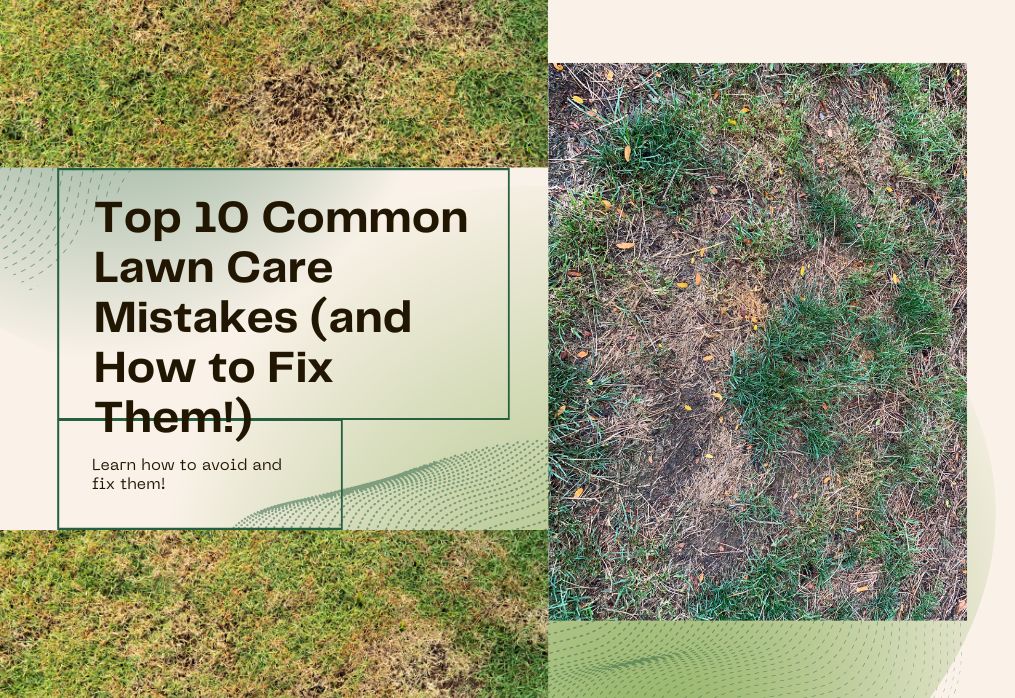Top 10 Common Lawn Care Mistakes (and How to Fix Them!)
The Ten Most Common Lawn Care Errors—and Their Solutions!
Top 10 Common Lawn Care Mistakes (and How to Fix Them!)
Though it may be challenging to achieve and maintain, a verdant lawn is a sight to behold. Frustration and lost work ensue when many homeowners inadvertently damage their lawns. Have no fear! To grow a lush, green lawn free of these typical problems, it helps to be aware of them. The most common lawn care blunders and their solutions are as follows: One common mistake is cutting the grass too short. Each cut should only remove a third of the blade’s height. Mowing the grass too short, or scalping, puts too much stress on it, which weakens its root structure and makes it more weedy and disease-prone. The solution is to mow more often and raise the mower blades so the grass stays at a healthy height. Second, you may harm your grass by watering it too much or too little. Overwatering encourages fungus and illness while underwatering leads to brown areas and stunted development. Fix: Water thoroughly and occasionally, aiming for around 1 inch of water each week. Water early in the morning to reduce evaporation.
- Using the wrong fertilizer: varied species of grasses have varied nutritional demands. Using the wrong fertilizer may hurt your grass and pollute the environment.
Fix: Get your soil tested to assess its pH and nutrient levels. Choose a fertilizer particularly suited for your grass type and environment.
- Applying too much fertilizer: Over-fertilizing may scorch your grass, harm the ecosystem, and promote weed development.
Fix: Follow the application directions on the fertilizer label carefully. Less is frequently more!
- Ignoring soil health: Healthy soil is the cornerstone of a healthy lawn. Compacted soil hinders water and nutrients from reaching the roots.
Fix: Aerate your grass periodically, especially if it’s compacted due to excessive traffic or clay soil. Add organic materials like compost to enhance soil drainage and structure.
- Not aerating or seeding at a suitable time: Aeration and seeding should be done at the right time of year based on your climate and grass type. Doing it at the wrong moment might be useless or even detrimental.
Fix: Research the ideal timing for aeration and sowing in your location. Typically, early fall is a favorable period for cool-season grasses, whereas spring or fall is excellent for warm-season grasses.
- Cutting using dull mower blades: dull blades shred the grass, making it more susceptible to disease and creating an uneven cut.
Fix: Sharpen your mower blades frequently, or replace them when they grow dull.
- Mowing the same way every time: This can compress the soil and produce ruts.
Fix: Vary the direction you mow each time to help prevent compaction and spread clippings evenly.
- Failing to utilize fertilizer: While over-fertilizing is detrimental, omitting to fertilize completely can deprive your lawn of important nutrients and contribute to poor growth.
Fix: Fertilize your lawn according to your soil test findings and grass type, following the label recommendations carefully.
- Wrong grass type for your climate: Choosing a grass type not suitable to your environment may result in a lawn that requires frequent upkeep.
Fix: Research the best grass kinds for your climate and soil conditions. Consider low-maintenance, drought-tolerant types if water conservation is a concern. By avoiding these frequent mistakes and following these guidelines, you can develop a healthy, beautiful lawn that flourishes with no work. Remember, a healthy lawn is not only aesthetically beautiful, but it also benefits the environment by absorbing rainfall, decreasing erosion, and providing a home for beneficial insects. Read here about – Brown and Patchy Lawn? Don’t Despair, Revive It Fast!
Bonus tip: Regularly inspect your grass for symptoms of issues like pests, infections, or nutrient deficits. Early identification and treatment can prevent modest difficulties from evolving into significant problems.
Happy grass maintenance!
Last Updated on 1 year ago by Anjali Mehra Ph.D. in Horticulture (Punjab Agricultural University)
- Best Lawn Grass for High-Footfall Religious Places in Punjab - December 29, 2025
- Why Lawn Grass Fails After Installation (Real Indian Case Studies) - December 25, 2025
- Nilgiri Grass vs Korean Grass – Price, Look & Maintenance Compared - December 23, 2025
